 klaus-michael schneider
klaus-michael schneider
Keywords: education |
Links: FOTW homepage | search | disclaimer and copyright | write us | mirrors

Last modified: 2021-08-26 by  klaus-michael schneider
klaus-michael schneider
Keywords: education |
Links: FOTW homepage |
search |
disclaimer and copyright |
write us |
mirrors
See also:
"Colegio Mochuelo Bajo" is located in the village of
Mochuelo Bajo, part of the Federal District of Bogotá.
The flag of the institute is described on the website
of the institute only by its colours, yellow, green and
white. The arrangement of the colours is not given.
Yellow represents people, the human touch and the cultural
diversity of the population.
Green represents the natural resources provided by the mountains,
arable lands and trees characteristic of the rural area of Ciudad
Bolívar.
White represents sociability and harmony, the social commitment
of the institute, and light and hope offerred to the population.
Ivan Sache, 17 January 2009
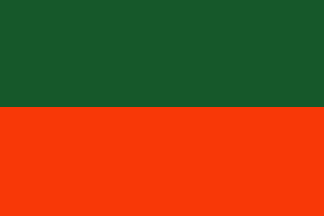 image by Ivan Sache, 1 January 2021
image by Ivan Sache, 1 January 2021
Gimnasio Moderno, located in Bogotá, was founded in 1914. The today's
institute was built in 1918 on on a plot offered by José María Samper and with
funds provided by Agustín Nieto Caballero, Rafael, Félix and José de Jesús
Salazar, Gabriel and Joaquín Camacho, Luis Eduardo Nieto, Ricardo Olano, Paulina
de Cano, Nicolás Camargo, Daniel Sáenz, Joaquín Samper, Sergio Martínez and José
María Samper. The founders belonged to the so-called "Centenary's Generation";
referring to the 100th anniversary of the independence of Colombia (1810), this
modernist movement wanted to rebuild the country destroyed by the Thousand Days
War, that had opposed the Liberals and the Conservatives in 1899-1902.
Gimnasio Moderno was thought as a "new school" free from any direct or indirect
influence of the Roman Catholic Church; quickly ranked among the best Colombian
schools, the institute was the first successful "new school" in South America.
The main promoter of Gimnasio Moderno was the educationalist Agustín Nieto
Caballero (1889-1975), who imported several modernist ideas from Europe and
North America, where he had studied and taught until 1914. He was in touch with
the most modernist educationalists of the time, for instance Ovidio Decroly,
Maria Montessori and Jean Piaget. Nieto subsequently represented Colombia in
several international conferences (for instance, at the League of Nations and
UNESCO), was a main contributor to the development of education in Colombia (for
instance, as the director of the National University), always promoting the
cultural relations between Colombia and the rest of the world. The first
director of Gimnasio Moderno (1918-1933) was Tomás Rueda Vargas (1879-1943),
also the author of historical novels and director of the Colombian National
Library.
Source:
http://www.gimnasiomoderno.edu.co/elgimnasio/
Ivan Sache, 10 November 2010
The flag of Gimnasio Moderno, designed in 1928 by the alumni, is horizontally
divided green-orange. Green symbolizes hope while orange symbolizes enthusiasm.
https://gimnasiomoderno.edu.co/gimnasio/historia/nuestrossimbolos
School
website
Photos
http://pablosalgado.com/blog/2014/3/14/centenario-del-gimnasio-moderno
https://gimnasiomoderno.edu.co/copa-tradicion-2017-i-2
https://gimnasiomoderno.edu.co/copa-tradicion-2019-i
https://desparchado.co/media/places/10450524_10152788032488419_7223741752745222649_n.jpg
https://www.facebook.com/Escuela-de-Maestros-Gimnasio-Moderno
Ivan Sache,
1 January 2021
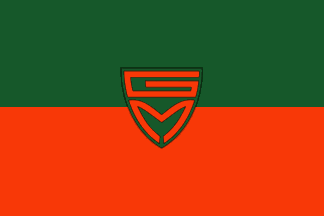 image by Ivan Sache, 1 January 2021
image by Ivan Sache, 1 January 2021
The centenary of the school was celebrated by the release of a postage stamp,
according to Resolution No. 4,582 issued on 26 November 2013. Of 800 $ in face
value, the stamp features a photo made by Natalia Ibáñez Lizarazo, showing the
school's main building, and, in front of it, the flags of Colombia and of the
school.
https://gimnasiomoderno.edu.co/estampilla-centenaria
School website
The "ceremonial" flag (seemingly used only indoors, beside the rector) is
charged with the school 's emblem in the center, which features stylized, orange
letters "G" and M" on a green shield.
Photos
https://gimnasiomoderno.edu.co/gimnasio/historia/nuestrossimbolos
http://fernoticias.com/2019/12/19/el-gimnasio-moderno-recibe-certificacion-great-place-to-study
Ivan Sache, 1 January 2021
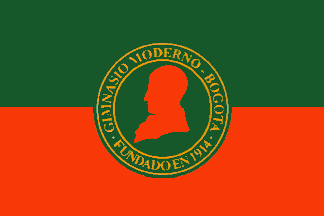 image by Ivan Sache, 1 January 2021
image by Ivan Sache, 1 January 2021
On 1 August 2012, the newly appointed rector of Gimnasio Moderno gave his
inauguration address beside a flag charged with the Wise Caldas seal.
Video
https://www.youtube.com/watch?v=un4tlXDwkkw
The seal features a
contour bust, drawn in profile, of Wise Caldas.
http://revistas.unisimon.edu.co/index.php/educacion/article/view/2182
Florentino Rico Calvano & Juan Spirko Payares. 2008. Crónica sobra el Gimnasio
Moderno. Revista Educación y Humanisma 14, 179-188.
The naturalist and
politician Francisco José de Caldas (1768-1816), aka Wise Caldas, supported the
independence and was executed by the Spanish troops.
Ivan Sache, 1 January 2021
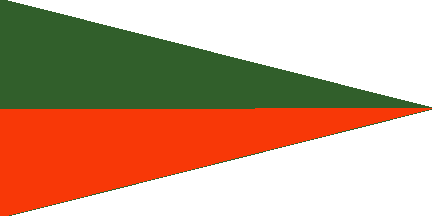 image by Ivan Sache, 1 January 2021
image by Ivan Sache, 1 January 2021
The sports pennant of Colegio Moderno is a triangular version of the school's
flag.
Photo
https://marymountbogota.edu.co/tetracampeonas-la-copa-tradicion-del-gimnasio-moderno/copa-tradicion-3
Ivan Sache, 1 January 2021
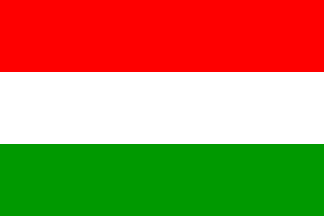 image by Ivan Sache, 06 August 2014
image by Ivan Sache, 06 August 2014
Liceo Moderno was established in 1959 by Luís Ernesto Rojas in Palmira (Valle
del Cauca Department).
The flag of the institute is horizontally divided red-white-green. Red
represents love and fraternity. White represents peace, tolerance, respect, and
friendship. Green represents knowledge, the natural environment, and hope.
Source:
http://liceomoderno.edu.co/simbolos/ - Institute's website
Ivan Sache, 06 August 2014
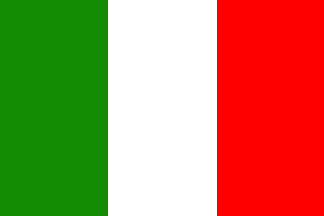 image by Ivan Sache, 15 December 2018
image by Ivan Sache, 15 December 2018
Colegio Gimnasio Mompiano (CGM) was established in 1991 in Cartagena de
Indias (Bolívar Department), as Jardín Infantil Mompiano. CGM is named for
borough Mompiano, part of the municipality of Brescia (Italy), where the sisters
Rosa (1866-1951) and Carolina Agazzi (1870-1945) established in 1895 a
kindergarten for poor children. Rejecting any sophistication and use of
expensive material, the Agazzi sisters were progressively overshadowed by Maria
Montessori. This did not prevent their principles, developed in several books,
to spread to Belgium, Switzerland, Romania, Spain, Germany and South America.
http://www.treccani.it/enciclopedia/rosa-agazzi_(Dizionario-Biografico)/,
Dizionario Biografico degli Italiani
The flag of CGM is vertically
divided green-white-red, a deliberate tribute to Italy and the Agazzi sisters.
http://mompianoedu.wixsite.com/mompianoedu/escudo, CGM website
Ivan Sache,
15 December 2018
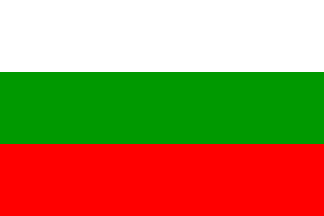 image by Ivan Sache, 31 October 2014
image by Ivan Sache, 31 October 2014
Escuela Normal Superior de Mompós (Bolívar Department) was established on 8
June 1944.
The flag of the institute is horizontally divided white-green-red. White is a
symbol of purity and peace. Green is a symbol of hope. Red is a symbol of love
and fire.
Source:
http://normaldemompox.tripod.com/html/pei.html - Institute's website
Ivan Sache, 31 October 2014
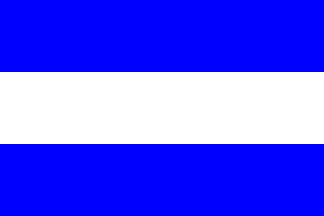 image by Ivan Sache, 13 November 2010
image by Ivan Sache, 13 November 2010
Colegio Mundo Nuevo, located in Timiza (Bogotá Capital District), was founded
in February 1986 by Alejandro Albarracin and María Teresa Rangel de Albarracin.
The flag of Colegio Mondo Nuevo, as shown on photos available on the institute's
website, is horizontally divided blue-white-blue.
http://www.colmundonuevo.edu.co/index.php/galeria/view/60
http://www.colmundonuevo.edu.co/index.php/galeria/view/61
http://www.colmundonuevo.edu.co/index.php/galeria/view/62
http://www.colmundonuevo.edu.co/index.php/galeria/view/29
http://www.colmundonuevo.edu.co/index.php/galeria/view/30
Ivan Sache, 13 November 2010
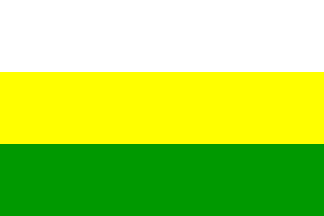 image by Ivan Sache, 24 November 2014
image by Ivan Sache, 24 November 2014
Institución Educativa Montecarlo - Guillermo Gaviria Correa is located
in Medellín (Antioquia Department).
Escuela Mixta Los Tanques was established on 24 January 1969 on a plot
offered by the Ramírez Johns family. The school was soon renamed
Escuela República de Barbados, to honour the newly independent
Caribbean state of Barbados. Colegio República de Barbados was
established in November 1995. Institución Educativa Guillermo Gaviria
Correa was established in 2011, to be renamed Institución Educativa
Montecarlo - Guillermo Gaviria Correa in May 2012.
The institute is named for Guillermo Gaviria Correa (1962-2003),
Governor of Antioquia (2001-2003), abducted by the FARC guerilla on 21
April 2002 when leading a non-violence march, and murdered on 5 May
2003 during an attempt of liberation by the Colombian Armed Forces.
The flag of the institute is horizontally divided white-yellow-green.
White is a symbol of purity.
Yellow is a symbol of the light of science.
Green is a symbol of aspiration to a better future.
Source:
http://www.iemontecarloguillermogaviriacorrea.edu.co/index2.php?id=9000&idmenutipo=1534&tag= - Institute's website
Photo:
http://ieporfiriobarbajacob.master2000.net/recursos/fotos/86/2203foto21.jpg
Ivan Sache, 24 November 2014
 image by Ivan Sache, 4 January 2009
image by Ivan Sache, 4 January 2009
"Colegio Montemorel" was founded on 1 October 1994
in Bogotá; classes started on 7 February 1995. In 1997, the
institute was transfered to its rural seat in the municipality of
Chía; it was recognized next year by the Department of
Cundinamarca (Decree No. 1655).
The name of the institute was formed on "monte",
"mounts", as a tribute to the Colombian mountains, and
"mora", "blackberry", a plant with a great
capacity of adaptation and production.
The flag of the institute, as shown graphically on the website
of the institute, is divided green- turquoise blue by a
SSW-NNE diagonal and charged in the middle with the emblem of the
institute placed on a white disk
The colours represent the harmony between heavens and the
natural environment, recalling the ecologic name of the college.
White represents purity and truth.
The emblem of the institute is made of a letter "M",
half blue, half green, on which walks a white silhouette. The two
parts of the "M" represent the outer and inner part of
knowledge, respectively. The outer knowledge develops the
rational skills of the left hemisphere of the brain, while the
inner knowledge relies on psychophysical strategies of human
development, involving the right part of the brain. In the middle
of the emblem is placed the essence of the process, a student
walking to self-knowledge.
Ivan Sache, 4 January 2009
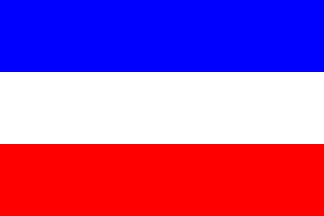 image by Ivan Sache, 08 September 2014
image by Ivan Sache, 08 September 2014
Institución Educativa Monseñor Alfonso Uribe Jaramillo was established on 15
April 1968 by María Zapata Ríos in La Ceja (Antioquia Department), as Escuela
San Cayetano. Institución Educativa Monseñor Alfonso Uribe Jaramillo was
eventually established by Resolution No. 6,233 of 7 July 2005. The institute is
named for His Grace Alfonso Uribe Jaramillo (1914-1993), Bishop of
Sonsón-Rionegro (1968-1993), Vice President of the Episcopal Conference of
Colombia (1972-1975).
The flag of the institute is horizontally divided blue-white-red. Blue
represents infinity. White represents God's presence, spiritual power, and
purity. Red represents force, energy, and vitality.
Source:
http://institucioneducativamauj.blogspot.fr/ - Institute's blog
Ivan Sache, 08 September 2014
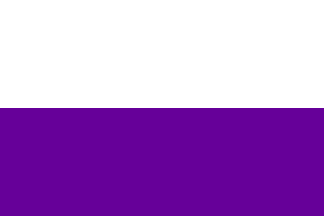 image by Ivan Sache, 13 July 2014
image by Ivan Sache, 13 July 2014
Institución Educativa Monseñor Francisco Cristóbal Toro was established in
1925 in the Aranjuez borough, part of the municipality of Medellín (Antioquia
Department). The institute is named for His Grace ("Monseñor") Francisco
Cristóbal Toro (1859-1942), Bishop of Socorro (1911), Santa Marta (1914),
Antioquia-Jericó (1917) and Antioquia (1941).
The flag of the institute
is horizontally divided white-purple. White is considered as the beginning and
end of anything and as a symbol of peace and innocence. Purple is a religious
symbol of change, renovation and open-mindedness; it is also a symbol of modesty
and a representation of international feminism.
http://www.medellin.gov.co/irj/go/km/dcs/educacionNuevo01dic/iemonsenorfranciscocristobaltoro/simbolos.html
Ivan Sache, 13 July 2014
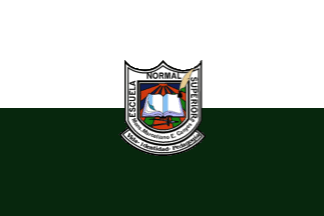 image by Ivan Sache, 19 October 2018
image by Ivan Sache, 19 October 2018
Escuela Normal Superior Monseñor Marceliano Eduardo Canyes Santacana
originates in Escuela Normal Rural de Señoritas, established in Leticia
(Amazonas) by Resolution No. 635, issued on 9 March 1959 by the Ministry of
National Education. ENS Monseñor Marceliano Eduardo Canyes Santacana was
established by Decree No. 20, issued on 7 April 2003 by the Government of
Amazonas, incorporating Jardín Infantil Rafael Pombo (est. by Resolution No.
18,883, issued on 12 December 1986).
The school is named for His Grace
Marceliano Eduardo Canyes Santacana (1913-1989), a Spanish Minor Capuchin friar
who served as Prefect of Leticia from 1952 to 1989.
http://normalleticia.blogspot.com/
School blog
The flag of ENS
Monseñor Marceliano Eduardo Canyes Santacana is made of two horizontal stripes
of equal size. In the upper part, the white stripe represents tolerance, respect
for difference and peace required to reach noble goals and live in harmonious
social context. In the lower part, the green stripe emphasizes the resources of
local biodiversity and the aspiration of development of the Amazonian people.
http://normalleticia.blogspot.com/2010/06/bandera-de-la-escuela-normal-superior.html
School blog
The coat of arms of ENS Monseñor Marceliano Eduardo Canyes
Santacana features in the inner part a book, sun rays, an ink pot, a quill, a
compass on a blue and green background. In the outer part is inscribed the name
of the institute; in base is inscribed the school's motto "Vida - Identittad -
Pedagogia" (Life - Identity - Pedagogy), on a white background.
The book
represents pedagogy, science and knowledge offered in the school, which aims at
integral development in the different areas of knowledge; it also emphasized the
interest for reading and study, required to improve the teaching process. The
ink pot and quill represents the compromise between education and investigation
achieved by the school in the process of teacher's education, taking into
account academic and pedagogic work in the interaction with students, in a local
and regional context with national and international emphasis. The compass
represents balance, accuracy and precision, which have to exist between
knowledge and pedagogic means, to be developed by students in search of truth.
The sun rays represent knowledge, life, light and emphasis required to achieve
being a teacher with high educational skills and leadership, able to transform
environment and to triumph over ignorance.
Blue represents the hydrologic
potential and the environmental resources and purity forming the base of the
firmament of pure air we breathe. Green represents hope, biodiversity of flora
and fauna, the feeling of identity and belonging to the immense Amazonian
vegetation. White represents tolerance, respect for difference and peace
required to reach noble goals and live in harmonious social context.
http://normalleticia.blogspot.com/2010/06/escudo-de-la-escuela-normal-superior.html
School blog
Ivan Sache, 19 October 2018
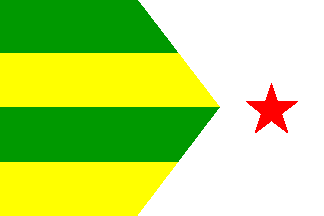 image by Ivan Sache, 18 July 2014
image by Ivan Sache, 18 July 2014
Institución Educativa Monseñor Ricardo Trujillo Gutiérrez is located in San
Isidro borough, part of the municipality of Cucutilla (Norte de Santander
Department). The institute is named for His Grace (Monseñor) Ricardo Trujillo
Gutiérrez (1916-2011), a parish priest who pushed in Cucutilla the building of a
road, of two schools, of the health center, and the pacification of the area.
The flag of the institute, selected in a contest, was designed by the
teacher Ildefonso Albarracín B. The flag is horizontally divided forest green-
olden yellow-forest green-golden yellow at hoist, ending in a triangular
pattern, and white with a red star at fly. The four stripes represent the
institutes that were merged by Decree No. 819 of 30 September 2002 to form
Institución Educativa Monseñor Ricardo Trujillo Gutiérrez:
- Escuela Urbana
José María Córdoba:
- Instituto de Promoción Social;
- Colegio
Departamental Integrado Monseñor Ricardo Trujillo;
- the rural schools.
The white part represents the new institute. The star represents the orientation
and guidance that enlightens the educational work and the personal achievements
of the members of the educational community. The flag uses the colours of the
municipal flag of Cucutilla:
- Green, as a symbol of hope, aspiration to
surpassing, progress and work;
- Yellow as a symbol of skills, intellectual
capacity, ethical, moral and cultural values, and responsibility;
- White as
a symbol of knowledge, unity, and of the municipality's patron saint, the
Immaculate Conception.
http://colmontrujillo.webnode.es/simbolos-institucionales/ - Institute's
website
image by Ivan Sache, 18 July 2014
 image by Ivan Sache, 16 July 2014
image by Ivan Sache, 16 July 2014
Institución Educativa Monseñor Victor Widemann was established in 1963 in the
San Antonio de Prado borough, part of the municipality of Medellín (Antioquia),
as Escuela Rural de Varones Pradito. Decree no. 739 of 25 September 1969 renamed
the institute Escuela Monseñor Víctor Wiedeman. The institute is named for a
local priest, His Grace (Monseñor) Victor Widemann (1912-1969)
The flag
of the institute is horizontally divided light blue-dark blue.
http://www.medellin.gov.co/irj/go/km/docs/educacionNuevo01dic/i.e.victorwiedemann/Simbolos.html
- Institute's webpage
Ivan Sache, 16 July 2014